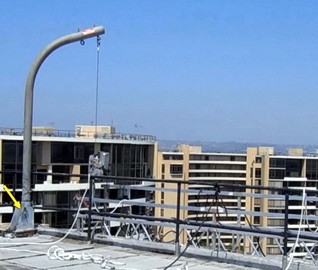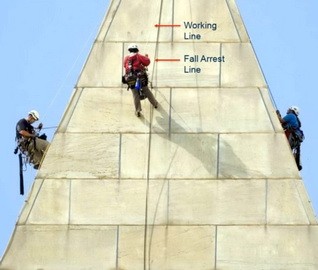On November 17, 2016, the U.S. Department of Labor's Occupational Safety and Health Administration (OSHA) issued a final rule updating its general industry Walking-Working Surfaces standards specific to slip, trip, and fall hazards. The new rule governs a wide variety of conditions, including fixed ladders, low-slope roofs, and rope descent systems. The rule also includes a new section under the general industry Personal Protective Equipment standards that establishes employer requirements for using personal fall protection systems. Portions of the new rule that became effective on January 17, 2017, have significant ramifications for many Chicago buildings, particularly older, mid-rise structures in need of certified anchorages for rope descent systems and older high-rises without sufficient equipment to cover their access needs via suspended scaffold.
In this one-hour webinar, WJE experts summarize critical portions of the new rule and give an overview of facade access methods and equipment, Chicago code provisions governing facade access, and responsibilities of building owners and managers. Continuing education credits are available.
A WJE Advisory: Advantages and Disadvantages of Using Rope Access Techniques
On November 17, 2016, OSHA issued a final rule updating the fall protection requirements of the General Industry Rules 29 CFR 1910, known as Subpart D, Walking-Working Surfaces. OSHA’s General Industry Rules apply to maintenance work performed on or in existing structures and facilities. The new rules cover a wide array of conditions and hazards.
Notably, effective January 17, 2017, the use of rope descent systems for maintenance activities is now restricted to locations no higher than 300 feet above ground level unless it is not feasible to access such heights by any other means or if those means pose a greater hazard than rope descent. The burden for proving that no other safe and feasible method exists rests with the entity whose employees are performing the work via rope descent.
A new WJE Advisory shares the advantages and disadvantages of using rope access techniques to access the facades of buildings based upon our project experience in this area as well as discussions with building owners and window washing contractors.
You can download and read it now.
* This webinar recording is made available for educational purposes. While we hope you will watch and learn something useful, please note that viewers aren't eligible for AIA credit.
RELATED INFORMATION
-
 Kurt P. Holloway, Senior AssociateWJE Northbrook MORE >People | Kurt P. Holloway, Senior Associate
Kurt P. Holloway, Senior AssociateWJE Northbrook MORE >People | Kurt P. Holloway, Senior Associate -
 Jonathan E. Lewis, Principal, Unit Manager, and Executive Director of Practice DevelopmentWJE Chicago MORE >People | Jonathan E. Lewis, Principal, Unit Manager, and Executive Director of Practice Development
Jonathan E. Lewis, Principal, Unit Manager, and Executive Director of Practice DevelopmentWJE Chicago MORE >People | Jonathan E. Lewis, Principal, Unit Manager, and Executive Director of Practice Development -
 Summary of new rule and overview of Seattle and Portland code governing facade access MORE >Webinars | Benefits and Provisions of New OSHA Rule
Summary of new rule and overview of Seattle and Portland code governing facade access MORE >Webinars | Benefits and Provisions of New OSHA Rule -
 Webinar summarizing new OSHA rule that will have significant ramifications for many buildings MORE >Webinars | Prepare Your Building for Compliance with New OSHA Rules
Webinar summarizing new OSHA rule that will have significant ramifications for many buildings MORE >Webinars | Prepare Your Building for Compliance with New OSHA Rules -
 Insight into OSHA requirements and how to ensure structurally adequate supports MORE >Webinars | Facade Access Equipment: Is Your Building OSHA Compliant?
Insight into OSHA requirements and how to ensure structurally adequate supports MORE >Webinars | Facade Access Equipment: Is Your Building OSHA Compliant?































